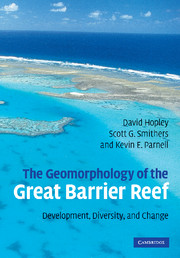Book contents
- Frontmatter
- Contents
- Preface
- Acknowledgements
- 1 Geomorphology and the Great Barrier Reef
- 2 Foundations of the Great Barrier Reef
- 3 Sea level: a primary control of long-term reef growth and geomorphological development
- 4 Oceanography, hydrodynamics, climate, and water quality as influences on reef geomorphological processes
- 5 Spatial analysis of the morphology of the reefs and islands of the Great Barrier Reef
- 6 The non-reefal areas of the continental shelf
- 7 Fringing and nearshore coral reefs
- 8 The mid-shelf reefs of the Great Barrier Reef
- 9 The coral reefs of the outer shelf of the Great Barrier Reef
- 10 Islands of the Great Barrier Reef
- 11 The accumulation of the Holocene veneer to the Great Barrier Reef
- 12 The Holocene evolution of the Great Barrier Reef province
- 13 Geomorphology's contribution to the understanding and resolution of environmental problems of the Great Barrier Reef
- References
- Geographic index
- Subject index
2 - Foundations of the Great Barrier Reef
Published online by Cambridge University Press: 22 August 2009
- Frontmatter
- Contents
- Preface
- Acknowledgements
- 1 Geomorphology and the Great Barrier Reef
- 2 Foundations of the Great Barrier Reef
- 3 Sea level: a primary control of long-term reef growth and geomorphological development
- 4 Oceanography, hydrodynamics, climate, and water quality as influences on reef geomorphological processes
- 5 Spatial analysis of the morphology of the reefs and islands of the Great Barrier Reef
- 6 The non-reefal areas of the continental shelf
- 7 Fringing and nearshore coral reefs
- 8 The mid-shelf reefs of the Great Barrier Reef
- 9 The coral reefs of the outer shelf of the Great Barrier Reef
- 10 Islands of the Great Barrier Reef
- 11 The accumulation of the Holocene veneer to the Great Barrier Reef
- 12 The Holocene evolution of the Great Barrier Reef province
- 13 Geomorphology's contribution to the understanding and resolution of environmental problems of the Great Barrier Reef
- References
- Geographic index
- Subject index
Summary
Introduction
For much of its length even the innermost reefs of the Great Barrier Reef (GBR) are beyond sight of the mainland. The main reef tract occupies the outer 30% to 50% of the shallow (< 60 m) waters of the continental shelf which varies from about 250 km in width in the south central GBR to less than 40 km near Cape Weymouth. Whilst fringing reefs occur around many continental islands, some of which are located up to 70 km from the mainland shore, reefs attached to the mainland are rare, especially south of Cairns. Nonetheless, no study of the evolution of the GBR could ignore the geology and geomorphology of the adjacent mainland of north-east Australia. The continental shelf upon which it rests has formed from terrigenous sediments eroded from the Eastern Highlands (Symonds et al., 1983), and as Lloyd (1977) noted, the geology of the shelf is closely related to the onshore geology of Queensland. For a large part of their history the GBR foundations have been part of the mainland as, during major glaciations of the Quaternary, sea level dropped to expose the shelf edge. Today, the direct influence of the mainland (including Papua New Guinea) in the form of runoff, sediment, and nutrients may be restricted to the Reef north of 18° S but along the entire coastline south to Fraser Island the sedimentary and geomorphological record of the last 8000 years or so greatly augments our understanding of the final phases in the evolution of the GBR which are the focus of this book.
- Type
- Chapter
- Information
- The Geomorphology of the Great Barrier ReefDevelopment, Diversity and Change, pp. 18 - 41Publisher: Cambridge University PressPrint publication year: 2007



